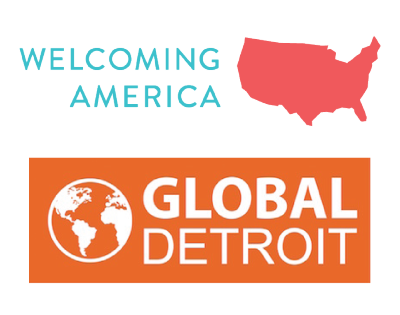Ohio Demonstrates Immigration Can Be a Uniter
To say that WE Global’s Ohio members influenced Governor John Kasich’s creation of the new Office of Opportunities for New Americans is an understatement. Tracing roots back to meetings in 2015, six WE Global members in Ohio (Akron, Cincinnati, Cleveland, Columbus, Dayton, and Toledo-Lucas County) began meeting as the Ohio Welcoming Initiatives Network (OWIN) to share best practices and to strategize on how they could drive a statewide agenda to make the state more welcoming and build a more inclusive economy. Over the following years, OWIN met with various officials in Governor Kasich’s Administration, which eventually led to the creation of a new Ohio Office of Opportunities for New Americans in May 2018.
The work of OWIN was enhanced by numerous partners within and external to the WE Global Network. The Michigan Office for New Americans (MONA), created by Republican Michigan Governor Rick Snyder, as well as the Maryland Skilled Immigrant Task Force, provided not only models for Ohio, but thoughtful advice. Welcoming America, Global Detroit, New American Economy, and WES Global Talent Bridge all provided research, participated in calls, helped provide administrative support, and even traveled to Columbus numerous times to participate in internal OWIN meetings, as well as meetings with Kasich officials.
After the office was formed, its staff embarked on a series of listening sessions across the state and issued its “One Ohio, Many Stories” report, subtitled “Strategies for Helping New Ohioans Integration, Contribute and Become a Thriving Part of Ohio’s Success” in December 2018. According to the report, the listening sessions were a virtual who’s who of OWIN/WE Global membership in Ohio, as nine of the ten sessions were co-hosted by OWIN/WE Global members.
The listening sessions highlighted a need to make immigrants aware of state resources that exist to help integration. The report notes the state’s role in ESL programs, job training, and job search resources, as well as state-sponsored business advisors, but recounts feedback from the listening sessions that immigrants are unaware of many of these resources. The report calls for increasing awareness as a top priority for the new state office. In response, the Office of Opportunities for New Americans built and is promoting its website: www.newamericans.ohio.gov.
The report outlines some basic economic arguments on why Ohio should welcome, encourage, and facilitate immigrant integration. Noting that the Ohio economy is facing worker shortages and that the Ohio population is aging, the report notes that immigrants to Ohio are younger and more likely to be of working age. In fact, somewhat remarkably, the report states “Since the inception of the Office, in less than six months, several employers have reached out to our office to ask us to connect them with immigrants to fill their workforce needs.” It also notes that immigrants in Ohio are significantly more likely to be college-educated, with 42.1 percent of immigrants possessing a four-year degree compared to 26.7 percent of U.S.-born Ohioans.
The Ohio Office of Opportunities for New Americans is organized around three pillars: jobs, education and training, and growing businesses. To facilitate access to jobs, the report stresses connecting immigrants with existing state job search resources, as well as making GED attainment more accessible. It calls for “Work[ing] with certification and licensing boards, educational institutions and employers to assist immigrants with advanced skills and degrees to move quickly into their field [while] encourage[ing] options for earning while working in the field, rather than starting over.”
The report touches on the economic benefits of recruiting more international students to Ohio colleges and universities, as well as retaining them to work in Ohio after graduation. Governor Kasich supported broad proposals to do so, including the creation of an initiative and report at the Ohio Department of Higher Education earlier in his administration—Ohio Global Reach to Engage Academic Talent (Ohio GREAT).
The Ohio Office of Opportunities for New Americans report discusses the contributions of immigrant entrepreneurs and calls on the state’s business development arm to encourage its small business counselors to visit the ethnic neighborhoods in their regions to build awareness and increase utilization of state services by immigrant businesses.
The report, without specifically calling attention to it, stresses the state’s role as a convener. For example, in one section it calls for gathering and sharing examples of best practices for ensuring immigrant-friendly workplaces. In its recommendations on helping immigrants to build English language skills, the state’s role as convener is evident:
- Gather information about agencies and companies that offer on-the-job English classes and job-skills training. Use the information to identify best practices that can be disseminated to other companies and industry groups around the state.
- Raise awareness of ESOL classes through the [Ohio Office of Opportunities for] New Americans website and contacts with social service agencies.
- Collaborat[e] with the Department of Higher Education to build ESOL curriculum that fits different skill levels.
- Work with businesses to develop a list of best practices with examples of workplace language-learning programs that have been developed.
The report concludes with a Progress Report, identifying the status of 28 actions to pursue 15 opportunities, complete with lead and support agencies within state government. By providing such a detailed agenda and engaging agency stakeholders throughout state government, the Ohio Office of Opportunities for New Americans is demonstrating that it is taking its tasks of helping to integrate immigrants and building a more inclusive Ohio economy seriously.
The fact that an initiative like this was created by a Republican Governor in a swing state critical to Donald Trump’s election demonstrates that there is another narrative in Middle America—one of welcoming and inclusion, built on the foundation of the economic benefits of immigrant integration. The Ohio state office and report likely would never have happened without the hard work and tenacious commitment of the OWIN/WE Global members on the ground. As national media portray America as a nation completely gridlocked and divided on immigration, immigrant economic development efforts in Ohio and across the Midwest are proving that a more pragmatic, welcoming, and thoughtful narrative is playing out in local communities. This local narrative is one that includes Republicans and Democrats–and is one that is advancing the economic interests of immigrants and non-immigrants alike.



